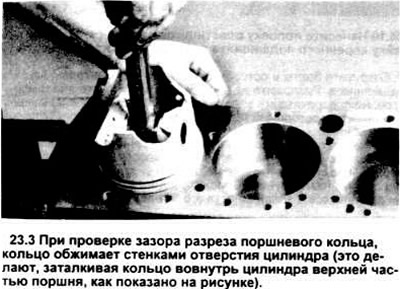2. Lay out a combination of pistons with connecting rods and sets of new rings for each cylinder so that when measuring side clearances and assembling the engine, the piston rings are in the selection with the same piston and cylinder.
3. Insert the top (number one) ring into the first cylinder, and by pushing inward with the upper part of the piston, ensure that it is compressed by the walls of the cylinder (see picture). The ring should be at the bottom of the cylinder at the bottom of the stroke.

4. To check the gap of the cut, insert the feeler gauges into the cut of the ring until you select the one that matches the width of the cut (see picture). The probe should pass between the ends of the ring with some resistance. Compare the measurement result with the value specified in the specification. If the gap is greater or less than the specified value, make another check; finally install only correctly selected rings.

5. If the gap is too small, increase it, otherwise the ends of the ring will catch each other when the engine is running, which will lead to serious damage. The gap can be increased by carefully filing the ends of the ring with a file. Place the file in a soft-jawed vise, join the ends of the ring on the file, and slide the ring slowly over it to remove excess material. When performing this operation, move the ring along the file in only one direction - out and in.

6. The critical value of the cut gap - maximum - corresponds to 1.016 mm (0.040 inch). Recheck to make sure rings are correctly fitted.
7. The procedure must be repeated for each ring installed in the first cylinder, and, accordingly, for all rings of the remaining cylinders. Remember to select pistons and rings for each cylinder.
8. After checking / adjusting the gaps of the ring cuts, the latter can be installed on the pistons.
9. The lowest ring on the piston - oil scraper - is installed first. It is assembled from three separate components. Place spacer or expander in groove (see picture). If using an anti-rotation shank, make sure it is inserted into the ring groove hole. Then install the bottom rail. When installing the wiper edges of the oil scraper ring, in order to avoid damage, do not use a special tool for installing piston rings.

Instead, place one end of the side guide in the groove between the spacer/expander and the ring surface, and while holding it in place, thread the guide around the piston into the groove (see picture). In the same way, then install the top guide.

10. After installing all three components of the oil scraper ring, check its correctness - the upper and lower guides should move easily in the groove around the piston.
11. Next put the ring number 2 (average). It has a stamp that should be on the outside when installed and facing towards the top of the piston.
Note: Always strictly follow the instructions printed on the package or ring box - different manufacturers give different recommendations. Do not confuse the top and middle rings as they have different cross sections.
12. Use a ring installation tool, making sure that the ring is turned with the mark towards the top of the piston. Lower the ring into the middle groove of the piston (see picture). Do not stretch the ring more than is required to fit the piston.

13. Install the ring number 1 in the same way (top). The label must be outside Do not confuse rings with numbers 1 and 2.
14. With the rest of the rings and pistons, the procedure is repeated.
Visitor comments